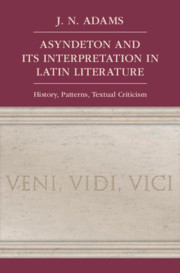Book contents
- Asyndeton and its Interpretation in Latin Literature
- Frontispiece
- Asyndeton and its Interpretation in Latin Literature
- Copyright page
- Contents
- Preface
- Acknowledgements
- Abbreviations
- Part 1 Introduction
- Part 2 ‘Grammatical’ Types
- Part 3 Semantic Types
- Part 4 Structures
- Chapter XVI Rule of Ascending Length (?)
- Chapter XVII Correlative Distribution
- Chapter XVIII End-Of-List Coordination and ‘Weak’ Asyndeton Bimembre
- Chapter XIX Accumulations of Asyndeta: a Few Patterns
- Chapter XX Discontinuous Asyndeton and Conjunct Hyperbaton
- Chapter XXI Asyndetic Pairs Dependent on a Single Preposition
- Part 5 Genres And Texts
- Part 6 Conclusions
- Bibliography
- Subject Index
- Index Mainly of Selected Pairs and Longer Sequences
- Selective Index Locorum
Chapter XX - Discontinuous Asyndeton and Conjunct Hyperbaton
from Part 4 - Structures
Published online by Cambridge University Press: 13 May 2021
- Asyndeton and its Interpretation in Latin Literature
- Frontispiece
- Asyndeton and its Interpretation in Latin Literature
- Copyright page
- Contents
- Preface
- Acknowledgements
- Abbreviations
- Part 1 Introduction
- Part 2 ‘Grammatical’ Types
- Part 3 Semantic Types
- Part 4 Structures
- Chapter XVI Rule of Ascending Length (?)
- Chapter XVII Correlative Distribution
- Chapter XVIII End-Of-List Coordination and ‘Weak’ Asyndeton Bimembre
- Chapter XIX Accumulations of Asyndeta: a Few Patterns
- Chapter XX Discontinuous Asyndeton and Conjunct Hyperbaton
- Chapter XXI Asyndetic Pairs Dependent on a Single Preposition
- Part 5 Genres And Texts
- Part 6 Conclusions
- Bibliography
- Subject Index
- Index Mainly of Selected Pairs and Longer Sequences
- Selective Index Locorum
Summary
Frequently a coordinated pair (or longer sequence), of adjectives, nouns or other parts of speech, is split up by the insertion of a word or phrase to follow the first member of the coordination (see e.g. Devine and Stephens 2006: 586–91, calling the pattern ‘conjunct hyperbaton’; also Hofmann and Szantyr 1965: 693, Gray 2015: 65–6). A classic example in English is brave man and true. In Latin too it is often homo (or uir) that is the intrusive term, as at Cic. Har. resp. 28: Brogitaro Gallograeco, impuro homini ac nefario, Sest. 56 Brogitaro, impuro homini atque indigno illa religione (in both places with the same referent);1 see further e.g. for homo, Cic. Att. 5.15.3, 5.21.6, Fam. 1.9.19, Prov. cons. 15, etc., and for uir instead of homo, Cic. Fam. 7.18.1 esse fortem uirum et constantem, Fin. 2.80 et bonum uirum et comem et humanum fuisse, Livy 8.8.16 strenuus uir peritusque militiae. At Catull. 12.8–9 (est enim leporum | differtus puer ac facetiarum) puer has the same function.
- Type
- Chapter
- Information
- Asyndeton and its Interpretation in Latin LiteratureHistory, Patterns, Textual Criticism, pp. 220 - 224Publisher: Cambridge University PressPrint publication year: 2021



